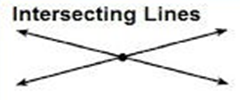CLASS-6
GEOMETRY - INTERSECTING LINES
INTERSECTING LINES -
Intersecting lines are two or more lines that cross each other at a common point, forming an intersection. The point where the lines meet is called the point of intersection. Unlike parallel lines, which never meet, intersecting lines share at least one common point.

Key points about intersecting lines include:
- Point of Intersection:- This is the point where the lines cross each other. If two lines intersect, they have exactly one point in common. If more than two lines intersect, they may share multiple points.
- Angles at the Intersection:- When lines intersect, they form angles at the point of intersection. These angles can vary in measure depending on the orientation of the intersecting lines.
- Symbol:- There is no specific symbol used to denote intersecting lines. Instead, the concept is often described or implied in a geometric context.
- Collinear Points:- Points that lie on the same line are called collinear points. If two lines intersect, the point of intersection and the points on each line leading up to the intersection are collinear.
- Linear Pairs:- When two lines intersect, they form linear pairs of angles. A linear pair is a pair of adjacent angles whose non-common sides are opposite rays, forming a straight line.
- Transversals:- When a transversal (a line that intersects two or more other lines) crosses a pair of intersecting lines, it creates corresponding angles, alternate interior angles, alternate exterior angles, and consecutive interior angles.
Understanding intersecting lines is fundamental in geometry, and it has various applications in different fields. For example, in transportation planning, roads often intersect, and understanding the angles at intersections is crucial for designing safe and efficient traffic flow. In mathematics, the study of intersecting lines is part of geometry and helps form the basis for more advanced concepts in algebra and calculus.